
This is a place for gardeners, plant lovers, explorers, cooks and eaters, readers and writers, walkers, lookers, wonderers and wanderers, collectors, creators, tinkerers, savers, builders, and those born curious.
You Grow Girl™ was launched by Gayla Trail in February 2000 and has grown into a thriving project that speaks to a new kind of gardener, seeking to redefine the modern world relationship to plants. This contemporary, laid-back approach to organic gardening places equal importance on environmentalism, style, affordability, art, and humour. The project’s aim has always been to promote exploration, excitement and a d.i.y approach to growing plants without the restrictions of traditional ideas about gardening.
About Gayla
GAYLA TRAIL is a writer, photographer, and former graphic designer with a background in the Fine Arts, cultural criticism, and ecology. She is the author, photographer, and designer of best-selling books on gardening, garden to table cooking, and preserving including: You Grow Girl: The Groundbreaking Guide to Gardening (Simon & Schuster, 2005), Grow Great Grub: Organic Food from Small Spaces (Clarkson Potter/Random House, 2010) [Since translated into German, Croatian, and Portuguese.], Easy Growing: Organic Herbs and Edible Flowers from Small Spaces, “Drinking the Summer Garden: Homegrown Thirst Quenchers, Concoctions, Sips, and Nibbles” (Summer 2012), and “Grow Curious: Creative Activities to Cultivate Joy, Wonder, and Discovery in Your Garden” (2017).
Gayla’s work as a writer and photographer has appeared in O Magazine, New York Times, Newsweek, The Globe and Mail, Organic Gardening Magazine, ReadyMade, Domino, Budget Living, Garden Making, Gardening Life, Gardens Illustrated, LA Times, Life Magazine, and more. She is a frequent speaker and spokesperson on the topics of urban gardening, ecology, home preserving, and community.
Media
Download a hi-res, print quality photograph of Gayla or find out more about her here. You will also find photos of events and workshops, and some press here.
Personal Background

One of the main reasons I started You Grow Girl™ nearly two decades ago was because I could not find a gardening media that reflected my experiences as a young, urban gardener working with a microscopic budget. I seemed to be the antithesis of everything a gardener was represented to be, and my gardens (the hot roof of my apartment building and a scrap of City-owned land alongside) were definitely not the sort of green spaces fancy magazines sent photographers out to capture.
To complicate matters, my background is not what you’d expect from an obsessive gardener, let alone a professional garden writer. I grew up in Ontario, Canada, in a middling, working class townhouse complex. There was a backyard, but it was hardly large enough to claim the title. The “gardens” as I recall them, were nearly non-existent. Back then, Nature was a fallow field behind the Food City plaza. Consequently, overgrown parking lots, derelict spaces, and urban brownfields are still some of my most favourite and inspiring places to spend time.
However strong my gardener’s desire to cultivate and control, there remains a fondness in my heart for an unintentional, uncultivated mess.
I remember my first plant fondly: It was a little parsley grown from seed in a cup. I was five. And even though parsley is a biennial, and the plant is long since dead, I still think about that little seedling and imagine it living on through its progeny. There have been countless plant loves since and many more that I’m yet to discover and explore. While growing food is my forte, I’m a fairly equal opportunity plant lover with obsessions in a wide assortment of plant families.
I have often cited my maternal grandmother and a bucket of potatoes growing on her tiny, senior citizen’s hi-rise balcony as the inspiration for my life as an urban gardener. Scylla did not shepherd me into the world of gardening as is often the garden writer’s story. But she and countless other new Canadians living in this wonderfully multicultural city I live in (Toronto) have shown me by example that one does not need a backyard or a nicely padded bank account to grow your own food, delight in the wonder of cultivating plants, or become a really great gardener.
As an adult I have grown a string of gardens in urban spaces. And for one short summer there was a sunny backyard in a house I shared with several university students; the home of my first, successful vegetable patch.
The following articles and posts delve further into my background, my search to better understand my West Indian background, and my approach to gardening.
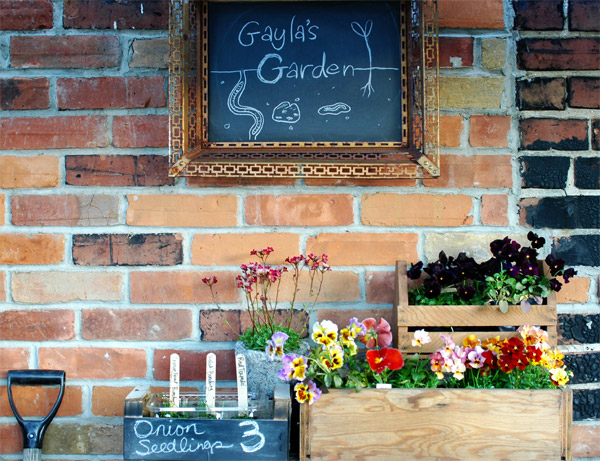
My Gardens
After countless transformations, this site has become, more than anything, an account of my personal experiences with nature, plants, and gardens, and in some cases presents a record of urban gardens I have built and tended through the years. I am my own audience, and I think it’s important to show other aspiring gardeners facing similar limitations what is possible with a bit of ingenuity, perseverance, and shifted expectations.
Orto (Terra Firma)
In late October 2010 I moved into a small house in Toronto with a bowling alley backyard (about 17 ft X 50 ft) and a small, ramshackle, blue shed. This yard has seen massive transformation in the few years I have been here including removal of all of the grass (just 2 people with shovels!) as well as the building of several raised beds, pathways, and a compost bin. The sandy, well-draining soil has allowed me to experiment further with drought tolerant plants and build a cactus garden. Despite the yard, I continue to grow in containers. In fact I have managed to cram more containers into this space than I had on the roof!
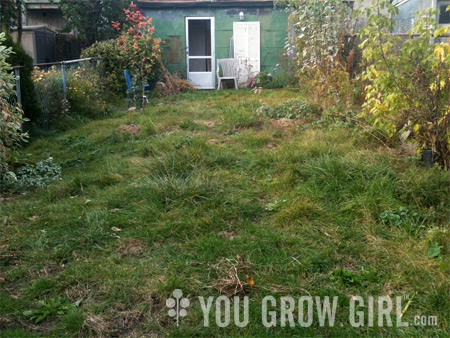
The yard when we moved in, November 2010.
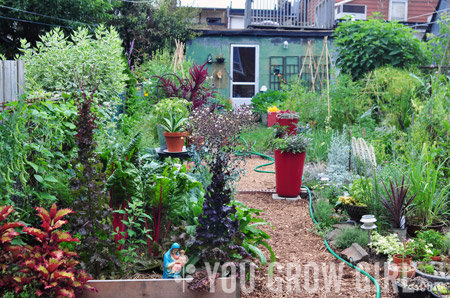
July 2011.
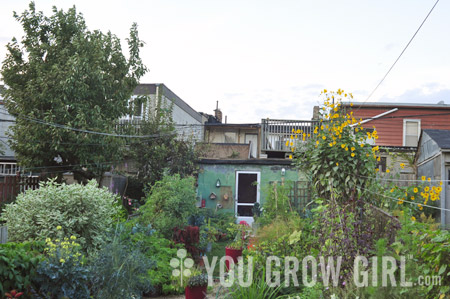
September 2011.
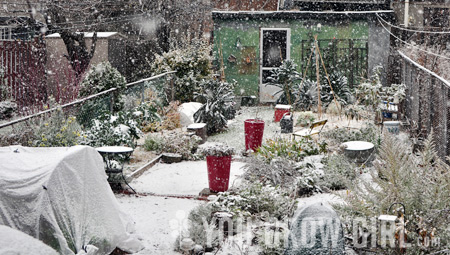
Winter 2011.
Read posts about the Orto Garden.
The Roof Garden
While not a traditional gardening space, this sanctuary in the sky was once my baby and the closest to my heart and home. It also functioned as a growing lab, where I tested new varieties and put plants to the test to learn first-hand what is possible in a pot. The downsides were: no outdoor tap, a punishing exposure to wind, sun, heat, and an uncontrollable assortment of urban wildlife who stopped by daily to feast on the banquet.
I gardened on the roof for over 15 years and by the time I moved I had grown just about every food plant you can imagine in containers of all sorts and sizes.
Read posts about the Roof Garden.
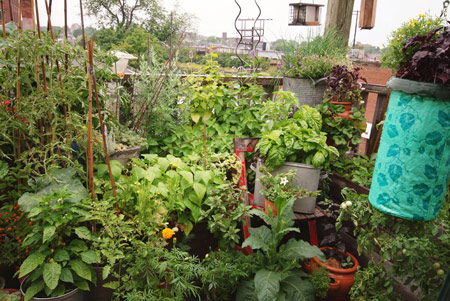
Summer 2007.

Late summer, 2008.
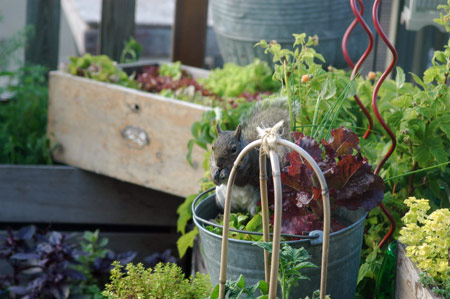
Squirrel banquet, 2008.

June 2009. A lot has changed since then.

June 2010.
The Street/Guerrilla Garden
I built this garden slowly over the course of about a decade on the side of my apartment building in City-owned land on a very busy, public corner. Again there was no outdoor tap and the soil when I started was as hard and compacted as concrete. Along the way, a car smashed into the wall, leaving automotive debris behind, and I dug up my fair share of used needles, syringes, discarded clothing, dog poo, and god knows what else from underneath the foliage. Despite the hurdles it was once a wonderful space to grow pretty perennials for many years.
But over the last few years gentrification had swept through the neighbourhood and the new, suburban bar crowd wreaked havoc on the garden. Gardening there turned into a constant battle to catch up to daily disasters and by the end I had lost the heart to continue. When I moved, I took out many of the more finicky plants and amazingly, the garden continues to live on its own. I go back seasonally to check up on it and hope that one day someone else will take it on.
Read posts about the Street Garden.

Street Garden, 2008.

Street Garden, June 2005.
The Parkdale Community Beer Garden
I can’t recall exactly how long I have been involved with the community garden, but it has been well over a decade now. I started out in one plot but the overhanging trees grew taller and I switched plots. That’s the nice, succinct version of the story. What actually happened is too complicated, but will show up in one of my books, someday.
Slowly over the years I moved from a more traditional vegetable garden to a perennial edible garden that includes a wide variety of hardy fruit bushes and herbs. In the summer I add annuals such as tomatoes and peppers, but the bones of the garden are perennial plants that are never dug up. I have since moved out of the neighbourhood but still keep the plot, although the community garden is currently in a limbo of sorts. Eventually I may be forced to remove all of the remaining perennials into my backyard and call it done.
Read posts about the Community Garden.

June 2008.
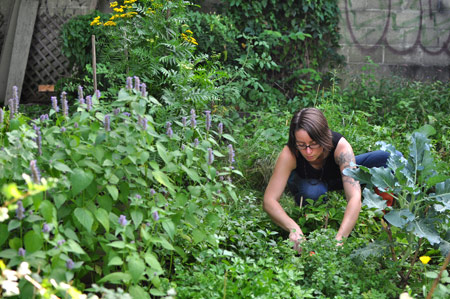
Gayla working at the Community Garden, August 2010.
The Yardshare Garden
Update: This property was sold in 2011 and the garden has since been dismantled.
This unusual addition came about by luck in the spring of 2010 when I was desperately looking for a new space to expand into. Community gardens have grown in popularity and it has become increasingly difficult to get a space. I applied for a plot at my ideal location, The High Park Allotments, but was so far down on the wait list I knew it would be an impossibility.
Thankfully, my friend Barry offered up the chance to grow in a yard that neighbours had been sharing for. In this space we grew communally and the yard owners receive produce in payment. I highly recommend this model for those who don’t have their own space in which to garden.
Read posts about the Yardshare Garden.
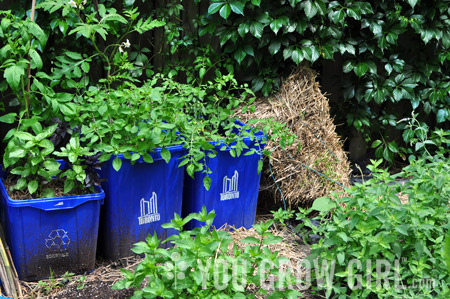
Morelle de Balbis growing in upcycled recycling containers at the Yardshare Garden, June 2010.